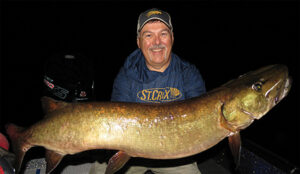By Steve Heiting
About an hour before moonrise, I drove my boat over the lake’s basin, my eyes scanning my electronics for signs of baitfish. Within minutes I started to see tell-tale “balls” of baitfish about seven to eight feet down, so I turned off the outboard and told my buddy it was time to start casting.
On my fifth cast my swimbait was rocked by a hard strike and I instinctively set the hook. I was first met with the wide headshakes indicative of a big musky, and the fish chose to slug it out down deep. When that didn’t work, it rocketed to the surface and I distinctly remember seeing the soft plastic bait completely inside the fish’s big mouth.

Eventually I worked the fish to the boat and Rob slid the net beneath it. After photos I released the musky, but before I could start casting again I needed to replace my leader and the front hook of the lure. The fish’s strike was that violent. Finally back in action, I resumed casting.
The full moon was to rise at 8:25 p.m., and at that precise time my swimbait was slammed again. This musky stayed down through the entire fight but soon was in the net. I released my second big fish in 48 minutes, and ten minutes later Rob’s bait was hit hard but he missed the hook-set. We continued casting until dark but no further action ensued.
I have fished for open water muskies for about 20 years, and it has become my favorite way of catching them in my home waters of northern Wisconsin. While finding suspended muskies in the “big ether” may seem a daunting task, consider that the active fish — the ones that will bite — are typically located within 15 feet of the lake’s surface. In essence, you’re fishing just as you would in the shallows but over the lake’s basin. Needing only to work your baits shallow over deep water puts you much closer to finding suspended fish.
Every lake has a suspended bite of some sort. Lakes that contain ciscoes are the classic such water and tend to produce more consistent action, but lakes that contain shiners and panfish have an open water bite, too. It’s just more spotty.
My electronics are my “underwater eyes” and will show me where baitfish are located. I visualize the baitfish schools like a giant weedbed or rock reef, and fish near them. The key is that they be within 15 feet of the water’s surface because that typically means the food chain is in action. For this reason, I don’t worry about thermocline and lake stratification — anytime I drive over a basin and see lots of baitfish in the top 15 feet of the water column, I stop and fish.
If the baitfish are deeper the muskies likely will be, too, and while they’re still catchable you will work for every one you get. In those times I think it’s more productive to cast to weeds and shallow structure.
If you’re having trouble locating baitfish, check the windy side of the lake, or at least the side where the wind blew yesterday. Wave action moves plankton, on which suspended baitfish feed, and the muskies won’t be far behind. Sometimes baitfish will be so close to the surface that you won’t see them with downward-pointing electronics, but you can with side imaging or live sonar. Toward evening you’ll often see feeding baitfish splashing or jumping at the surface.
Some muskies begin haunting open water as soon as they finish spawning. Their food is out there, so why shouldn’t they? This pattern continues until a lake’s thermal stratification begins to break down in early fall, in what some call the pre-turnover period. I don’t know if all the muskies leave deep water for the shallows at this time, but it sure seems that way.
Muskies over deep water respond to time of day and environmental triggers just like fish using weeds or structure. Periods of low light (clouds, evening) and moon events are important. One rule I suggest to open water newcomers is to try fishing the pattern when muskies are moving on more customary spots. If you only try it as a last-ditch effort on a difficult, post-frontal day, you’ll rarely have the success you need to develop the confidence to go back.
It’s important to remember that I typically only fish the top 15 feet of the water column, or less than the length of most boats. It requires only a snap or two of its tail for a muskie to cover that distance. Therefore, I want my baits running relatively shallow, say within five feet of the surface. Many who try this open water pattern think they need to get their baits deep and end up fishing beneath the muskies. Remember, muskies are always looking up.
Since you will likely be fishing near thousands of baitfish, it’s important that your bait stand out through either size, color or action. Typically I like larger baits, and if fishing a cisco-based lake I find that perch or fire tiger color patterns are often best because the color stands out from the majority of the baitfish. For lure action, I use twitches, hard rips, and speed and direction changes.
I’ve caught muskies on topwaters over 40 feet of water, but typically I will use a subsurface lure. Big spinners, crankbaits, soft plastics and swimbaits all work. Set the hook on anything that feels different during your retrieve. End every cast with a figure-8 or you’ll be sorry.
If you give suspended muskies a shot this year you may find yourself writing the next chapter of your fishing career.
